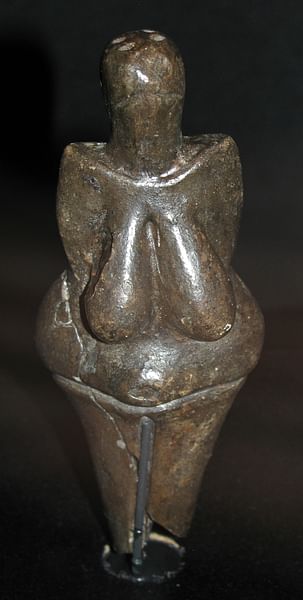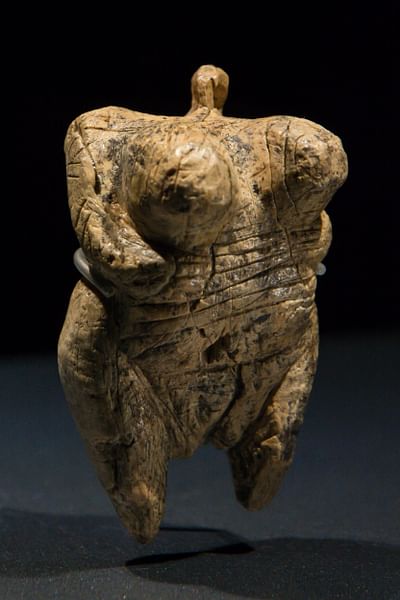What Does This Carved Figure Suggest About the Art of Paleolithic People Living Near Willendorf?
The term Venus figurine is used to describe the more than 200 pocket-size statuettes of voluptuous female figures that accept been constitute at Upper Paleolithic sites beyond Europe and some parts of Asia. "When paleoanthropologists refer to figurines as Venuses, [they] normally do so with air quotes" (von Petzinger, 95), because Venus figurines pre-engagement myths most the goddess Venus by thousands of years. The proper noun is derived, in part, from theories that associate these figurines with fertility and sexuality, 2 traits associated with the Roman goddess.
CHARACTERISTICS
The so-called Venus figurines date from between about 40,000 BCE and 10,000 BCE. They are more often than not quite minor with sizes typically ranging from 2.v cm to 10.ii cm though a few examples as large as 24 cm take been found. The most common textile used to carve these statuettes is mammoth tusk, but teeth, antlers, bone, and stone were also used. A very small number of sites produced clay figurines, which are amidst the earliest known examples of ceramic fine art. The figures are unremarkably voluptuous female nudes. Some of their features, such as their breasts, hips, stomachs and pubic areas, are greatly exaggerated while other characteristics are absent or downplayed. It is quite common for the figurines to be faceless with poorly defined arms and legs and a silhouette that is tapered at the top and bottom. The carvings ofttimes lack defined hands and feet. Given that the creators of these carvings were separated past xxx,000 years and hundreds of kilometers, it is remarkable that so many of them share the same traits.
THE Well-nigh COMMON Cloth USED TO Cleave VENUS FIGURINES IS MAMMOTH TUSK.
Important FINDS
While the majority of Venus figurines adapt to these voluptuous characteristics, private finds show that in that location is some diversity in terms of their materials and construction. They are as well quite diverse in terms of their location. They accept been found at sites all over Europe and as far afield as Siberia. Most have been plant at prehistoric settlement sites, both inside caves and at open-air locations. While extremely rare, some figurines have been found in burial places.
The oldest known Venus, the Venus of Hohle Fels, was constitute in a cave of the same name in Schelklingen, Germany and is believed to be between 35,000 and 40,000 years erstwhile. It is carved from wooly mammoth ivory. In place of a head, the Venus of Hohle Fels has a loop, which suggests it may accept been worn every bit a pendant. Many Venuses accept perforations that propose they may have been worn equally jewelry.
Ane of the best known Venus figurines is the Venus of Willendorf who is named for the location where she was found in Austria. The Willendorf Venus is around 25,000 years one-time. She was carved from limestone, another commonly used material.

The Venus of Laussel
The Venus of Laussel is also carved from limestone and shares many of the traits of a Venus figurine while remaining unique in terms of prehistoric art. Found in France and believed to be between 18,000 and 20,000 years old, this Venus is a rare example of a prehistoric bas-relief. Like many of these figures, the Laussel Venus was once covered in red ochre, an aspect that suggests a connexion with catamenia and fertility. Traces of this ochre are still visible to the naked center. She is holding a curved horn inscribed with 13 lines that may represent lunar or menstrual cycles.
Equally unique are the ceramic Venuses at Dolni Vestonice in the Czechia and Vela Spila in Croatia. They are the oldest examples of kiln-fired clay artifacts yet known. At Dolni Vestonice, they developed a mixture of clay and basis bone that frequently produced a cocky-glazing terminate in the kiln, causing many of the figures establish at this site to accept an unusual, shiny, blackness appearance. The Black Venus of Dolni Vestonice is the well-nigh well-known instance of a figurine fabricated with this material. While adequately unique in terms of her color and material, the Black Venus shares the curvaceous appearance of her counterparts constitute throughout Eurasia.

Black Venus of Dolni Vestonice
THEORIES About THEIR PURPOSES
What intrigues many scholars is the voluptuous nature of these figurines. They were produced at a time when the boilerplate woman would have been lean and muscular. For this reason, many researchers theorize that these figures were not portraits of real women, but religious icons. Their small size, which suggests that the figures may have been held in the easily during rituals, further supports this theory. Certainly, their diminutive dimensions made information technology easier for our nomadic ancestors to transport these potentially sacred objects from place to identify.
As the features that are exaggerated and emphasized in most of the carvings (large breasts, ample hips, protruding stomachs) are associated with fertile and pregnant women, it is possible that these female figures served as fertility symbols. Some scholars have besides posited that these figurines, which often appear pregnant, may depict a female parent goddess or a deity associated with childbearing. Those figurines that contain apertures that would accept allowed them to be strung, like the Venus of Hohle Fels, may have been worn as amulets to protect women during pregnancy and childbirth. Some Venuses were once anointed with red ochre while others were decorated with symbols that may be associated with lunar cycles; both of these aspects propose a connection to catamenia and fertility as well.

Venus of Hohle Fels
While the theory that Venus figurines were carved as fertility symbols or religious objects is the about unremarkably accustomed hypothesis, many other theories have been advanced to explicate the proliferation of these carvings. It has been suggested that they are dolls or portraits. Other researchers believe they may represent platonic beauty standards or serve every bit a kind of Paleolithic pornography. Given the vast range of time and geographic infinite over which these figurines were produced, it is possible that they may accept had multiple meanings and served multiple purposes. In reality, we do not have enough evidence to conclusively determine which, if whatever, of these theories, is accurate. Like most cultural items from the Upper Paleolithic era, their true meaning may never be known.
Ultimately, in terms of Paleolithic art, Venus figurines are rare. In fact, images of humans of any kind are quite uncommon and show up much afterward in the timeline of prehistoric art. Humans began creating fine art about 80,000 years ago, simply images of humans but show up between 30,000 and 40,000 years agone. At sites where multiple figurines accept been establish, it is rare for Venus-style statuettes to compose the majority. An equal number of animal subjects are often present, and many of the human figures are male or of ambiguous gender. Amongst all the art created by our prehistoric ancestors, images of animals were by far the almost commonplace, which suggests that to early modern humans, our species was not the most dominant or of import living fauna on world.
This article has been reviewed for accuracy, reliability and adherence to academic standards prior to publication.
Source: https://www.worldhistory.org/Venus_Figurine/
Post a Comment for "What Does This Carved Figure Suggest About the Art of Paleolithic People Living Near Willendorf?"